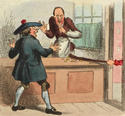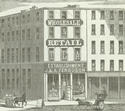 When Dorothy Wordsworth, the sister of the poet William Wordsworth, visited Glasgow in 1803 she was surprised to find that the shops were "large and like the London shops". In 1810 a Glasgow retailer commented that most of these shops "kept a little of everything, and if age was any advantage to their wares, their customers were sure to be well-suited". Most of the shops were poorly lit and sparsely furnished with highly priced goods on show. The most striking feature of the city's streets was the very large number of shops selling liquor. It was estimated that there were licensed premises for every fourteen families. So concerned was the Town Council that in 1828 an Act of Parliament was secured giving them powers to close many of these premises and regulate the opening hours of the remainder.
When Dorothy Wordsworth, the sister of the poet William Wordsworth, visited Glasgow in 1803 she was surprised to find that the shops were "large and like the London shops". In 1810 a Glasgow retailer commented that most of these shops "kept a little of everything, and if age was any advantage to their wares, their customers were sure to be well-suited". Most of the shops were poorly lit and sparsely furnished with highly priced goods on show. The most striking feature of the city's streets was the very large number of shops selling liquor. It was estimated that there were licensed premises for every fourteen families. So concerned was the Town Council that in 1828 an Act of Parliament was secured giving them powers to close many of these premises and regulate the opening hours of the remainder.
 By then shops had begun to be transformed with larger windows and a greater variety of stock, as shown by a painting in 1826 of the Trongate thronged with shops. At about this time the first shops were opened in Buchanan Street encouraged by the low rents and excellent location – "It was thought by many people to be perfectly absurd and that they would never pay". They were to be proved wrong. Robertson Stewart and John McDonald opened a wholesale drapery warehouse at 5 Buchanan Street in 1826 which was an immediate success. Three years later a fashionable arcade of shops with large windows was built across the road to link Buchanan Street to Argyle Street. This attracted shoppers and laid the foundation of Buchanan Street becoming a principal shopping thoroughfare.
By then shops had begun to be transformed with larger windows and a greater variety of stock, as shown by a painting in 1826 of the Trongate thronged with shops. At about this time the first shops were opened in Buchanan Street encouraged by the low rents and excellent location – "It was thought by many people to be perfectly absurd and that they would never pay". They were to be proved wrong. Robertson Stewart and John McDonald opened a wholesale drapery warehouse at 5 Buchanan Street in 1826 which was an immediate success. Three years later a fashionable arcade of shops with large windows was built across the road to link Buchanan Street to Argyle Street. This attracted shoppers and laid the foundation of Buchanan Street becoming a principal shopping thoroughfare.